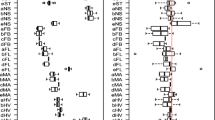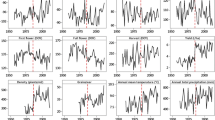Abstract
Knowledge of plant–weather relationships can improve crop management, resulting in higher quality and more stable crop yields. The annual timing of spring phenophases in mid-latitudes is largely a response to temperature, and reflects the thermal conditions of previous months. The effect of air temperature on the variability of hazelnut (Corylus avellana L.) phenophases (leafing, flowering) was investigated. Meteorological and phenological data for five cultivars were analysed over the periods 1969–1979 (P1) and 1994–2007 (P2) in Maribor, Slovenia. Phenological data series were correlated strongly to the temperature of the preceding months (R 2: 0.64–0.98) and better correlated to daily maximum and mean temperatures than to daily minimum temperatures. About 75% of phenophases displayed a tendency towards earlier appearance and a shorter flowering duration during P2, which could be explained by the significant temperature changes (+0.3°C/decade) from December to April between 1969 and 2007. An increase in air temperature of 1°C caused an acceleration in leafing by 2.5–3.9 days, with flowering showing higher sensitivity since a 1°C increase promoted male flowering by 7.0–8.8 days and female flowering by 6.3–8.9 days. The average rate of phenological change per degree of warming (days earlier per +1°C) did not differ significantly between P1 and P2. An estimation of chilling accumulation under field conditions during 1993–2009, between 1 November and 28 February, showed that all four of these months contributed approximately similar amounts of accumulated chilling units. The growing degree days (GDD) to flowering were calculated by an estimated base temperature of 2°C and 1 January as a starting date, given the most accurate calculations. In general, thermal requirements were greater in P2 than in P1, although this difference was not significant. Longer-time series data extended to other agricultural and wild plants would be helpful in tracking possible future changes in phenological responses to local climate.



Similar content being viewed by others
References
ARSO (2010) Climate data archive for the period 1969–2009. The Environmental Agency of the Republic of Slovenia. http://meteo.arso.gov.si/met/sl/app/webmet/. Accessed 12 January 2010
Baldocchi D, Wong S (2008) Accumulated winter chill is decreasing in the fruit growing regions of California. Clim Chang 87:153–166. doi:10.1007/s10584-007-9367-8
Baldwin B (2004) The potential for hazelnut production in Australia. Australas Farm Bus Manag J 1:84–92
Bastias R, Grau P (2005) Floral phenology of commercial cultivars and Chilean pollinizers of hazelnut (Corylus avellana L.) in Chile. Acta Hortic 686:151–155
Bergant K, Kajfež-Bogataj L, Črepinšek Z (2002) Statistical downscaling of general-circulation-model- simulated average monthly air temperature to the beginning of flowering of the dandelion (Taraxacum officinale) in Slovenia. Int J Biometeorol 46:22–32. doi:10.1007/s00484-001-0114-y
Chmielewski FM (2003) Phenology and agriculture. In: Schwartz MD (ed) Phenology: an integrative environmental science. Series: tasks for vegetation science. Kluwer, Dordrecht, pp 505–522
Chuine I, Cour P, Rousseau DD (1998) Fitting models predicting dates of flowering of temperate-zone trees using simulated annealing. Plant Cell Environ 21:455–466. doi:10.1046/j.1365-3040.1998.00299.x
Črepinšek Z (2005) Spring phenological events in Slovenia related to air temperatures. Arbor Phaenol 48:9–18
Črepinšek Z, Kajfež-Bogataj L, Bergant K (2006) Modelling of weather variability effect on fitophenology. Ecol Model 194:256–265. doi:10.1016/j.ecolmodel.2005.10.020
Črepinšek Z, Solar M, Štampar F, Solar A (2009) Shifts in walnut (Juglans regia L.) phenology due to increasing temperatures in Slovenia. J Hortic Sci Biotechnol 84:59–64
Emberlin J, Smith M, Close R, Adams-Groom B (2007) Changes in the pollen season of the early flowering trees Alnus spp. and Corylus spp. in Worcester, United Kingdom, 1996–2005. Int J Biometeorol 51:181–191. doi:10.1007/s00484-006-0059-2
Encyclopaedia Britannica (2010) Encyclopaedia Britannica Online. http://www.britannica.com/EBchecked/topic/479601/protandry. Accessed 4 December 2010
Galan C, Garcia-Mozo H, Vázquez L, Ruiz L, Diaz dela Guardia C, Trigo MM (2005) Heat requirement for the onset of the Olea europaea L. pollen season in several sites in Andalusia and the effect of the expected future climate change. Int J Biometeorol 49:184–188. doi:10.1007/s00484-004-0223-5
Germain E (1994) The reproduction of hazelnut (Corylus avellana L.): a review. Acta Hortic 351:195–209
Germain E, Sarraquigne JP (2004) Le Noisetier. Centre Technique Interprofessionnel des Fruits et Legumes, Paris
Gunderson CA, O’Hara KH, Campion CM, Walker AV, Edwards NT (2010) Thermal plasticity of photosynthesis: the role of acclimation in forest responses to a warming climate. Global Change Biol 16:2272–2286. doi:10.1111/j.1365-2486.2009.02090.x
IPCC (2007) Climate Change 2007—Synthesis Report. Contribution of Working Groups I, II and III to the Fourth Assessment Report of the Intergovernmental Panel on Climate Change. In: Pachauri RK, Reisinger A (ed) IPCC, Geneva, Switzerland
IPGRI (2008) Descriptors for Hazelnut (Corylus avellana L.). Biodiversity International. CIHEAM, FAO, Roma
Jato V, Rodríguez-Rajo FJ, Méndez J, Aira MJ (2002) Phenological behaviour of Quercus in Ourense (NW Spain) and its relationship with the atmospheric pollen season. Int J Biometeorol 46:176–184. doi:10.1007/s00484-006-0059-2
Kajfež-Bogataj L (2001) Changes in the minimum and maximum temperatures in Slovenia over the last 50 years. Research Reports, University of Ljubljana, Biotechnical Faculty 77:299–307
Kajfež-Bogataj L, Bergant K (2005) What might the climate of Slovenia look like in this century? Ujma, Ljubljana 19:218–223
Kluza-Wieloch M, Szewczak J (2006) Flowering phenology of selected wind pollinated allergenic deciduous tree species. Acta Agrobot 59:309–316
Kramer K (1994) A modelling analysis of the effects of climatic warming on the probability of spring frost damage to tree species in the Netherlands and Germany. Plant Cell Environ 17:367–377. doi:10.1111/j.1365-3040.1994.tb00305.x
Larcher W (1995) Physiological plant ecology, 3rd edn. Springer, New York
Larcher W (2003) Physiological Plant Ecology. Springer, Berlin
Lieth H (ed) (1974) Phenology and seasonality modelling. Ecological studies 8, Springer, New York
Luedeling E, Zhang M, Luedeling V, Girvetz EH (2009a) Validation od winter chill models using historic records of walnut phenology. Agr Forest Meteorol 149:1854–1864. doi:10.1016/j.agrformet.2009.06.013
Luedeling E, Zhang M, McGranahan G, Leslie C (2009b) Sensitivity of winter chill models for fruit and nut trees to climatic changes expected in California's Central valley. Agr Ecosyst Environ 133:123–131. doi:10.1016/j.agee.2009.04.016
Manzo P, Tamponi G (1982) Monografia di cultivar di nocciuolo. Istituto Sperimentale per la Frutticoltura Roma, Rome
Mehlenbacher SA (1991) Chilling requirements of hazelnut cultivars. Sci Hortic 47:271–282. doi:10.1016/0304-4238(91)90010-V
Menzel A, Sparks T, Estrella N et al (2006) European phenological response to climate change matches the warming pattern. Global Change Biol 12:1969–1976. doi:10.1111/j.1365-2486.2006.01193.x
Migliavacca M, Cremonese E, Colombo R, Busetto L, Galvagno M, Ganis L, Meroni M, Pari E, Rossini M, Siniscalco C, Morra di Cella U (2008) European larch phenology in the Alps: can we grasp the role of ecological factors by combining field observations and inverse modelling? Int J Biometeorol 52:587–605. doi:10.1007/s00484-008-0152-9
Piskornik Z, Wyzgolik GM, Piskornik M (2001) Flowering of hazelnuts cultivars from different regions under the climatic conditions of Southern Poland. Acta Hortic 556:529–535
Ruiz D, Campoy JA, Egea J (2007) Chilling and heat requirement of apricot cultivars for flowering. Environ Exp Bot 61:254–263. doi:10.1016/j.envexpbot.2007.06.008
Scheifinger H, Menzel A, Koch E, Peter C (2003) Trends in spring time frost events and phenological dates in Central Europe. Theor Appl Climatol 74:41–51. doi:10.1007/s00704-002-0704-6
Schleip C, Rutishauser T, Luterbacher J, Menzel A (2008) Time series modeling and central European temperature impact assessment of phenological records over the last 250 years. J Geophys Res 113:G04026. doi:10.1029/2007JG000646
Schleip C, Rais A, Menzel A (2009) Bayesian analysis of temperature sensitivity of plant phenology in Germany. Agric For Meteorol 149:1699–1708. doi:10.1016/j.agrformet.2009.05.014
Solar A, Štampar F (1997) First experiences with some foreign hazelnut cultivars (Corylus avellana L.) in Slovenia. Acta Hortic 445:83–89
Solar A, Štampar F (2009) Performance of Hazelnut Cultivars from Oregon in Northeastern Slovenia. Hortic Technol 19:653–659
Strauss F, Formayer H, Asamer V, Schmid E (2010) Climate change data for Austria and the period 2008–2040 with 1 day and km2 resolution. No 482010, Working Papers, University of Natural Resources and Applied Life Sciences, Vienna, http://econpapers.repec.org/RePEc:sed:wpaper:482010. Accessed 13 April 2011
Turcu E, Turcu I, Botu M (2001) Flowering of hazelnuts cultivars in Oltenia, Romania. Acta Hortic 556:365–370
Vučetić V, Vučetić M, Lončar Ž (2008) History and present observations in Croatian plant phenology. In: Nekovar J (ed) The History and Current Status of Plant Phenology in Europe, Vammalan Kirjapaino Oy, Brussels, COST 725, pp 44–50
Weinberger JH (1950) Chilling requirements of peach varietes. Proc Am Soc Hortic Sci 56:122–128
Wielgolaski FE (1999) Starting dates and basic temperatures in phenological observations of plants. Int J Biometeorol 42:158–168. doi:10.1007/s004840050100
Wilkinson J (2005) Nut growers's guide: the complete handbook for producers and hobbyists. Landlinks, Collingwood
Zhang T, Zhu J, Yang X (2008) Non-stationary thermal time accumulation reduces the predictability of climate change effects on agriculture. Agric For Meteorol 148:1412–1418. doi:10.1016/j.agrformet.2008.04.007
Acknowledgment
This work is part of the Horticulture P4-0013-0481 and Applicative Botany, Genetics and Ecology P4-0085-0481 programs supported by the Slovenian Research Agency. We hereby declare that all experiments described in this study comply with the current laws in Slovenia. We declare no conflict of interest regarding our article.
Author information
Authors and Affiliations
Corresponding author
Rights and permissions
About this article
Cite this article
Črepinšek, Z., Štampar, F., Kajfež-Bogataj, L. et al. The response of Corylus avellana L. phenology to rising temperature in north-eastern Slovenia. Int J Biometeorol 56, 681–694 (2012). https://doi.org/10.1007/s00484-011-0469-7
Received:
Revised:
Accepted:
Published:
Issue Date:
DOI: https://doi.org/10.1007/s00484-011-0469-7




